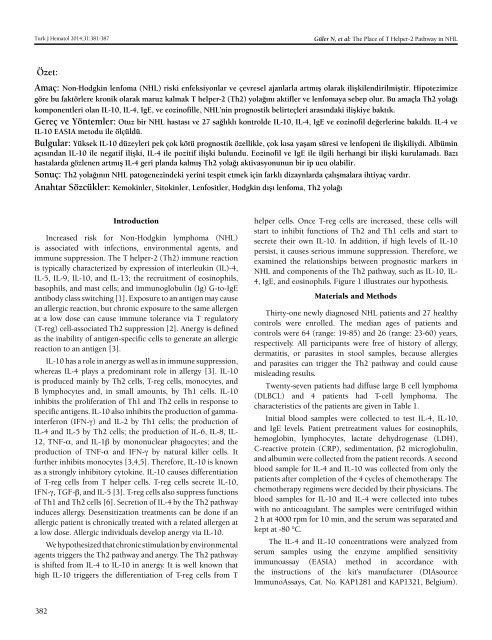Turkish Journal of Hematology Volume: 31 - Issue: 4
Create successful ePaper yourself
Turn your PDF publications into a flip-book with our unique Google optimized e-Paper software.
Turk J Hematol 2014;<strong>31</strong>:381-387<br />
Güler N, et al: The Place <strong>of</strong> T Helper-2 Pathway in NHL<br />
Özet:<br />
Amaç: Non-Hodgkin lenfoma (NHL) riski enfeksiyonlar ve çevresel ajanlarla artmış olarak ilişkilendirilmiştir. Hipotezimize<br />
göre bu faktörlere kronik olarak maruz kalmak T helper-2 (Th2) yolağını aktifler ve lenfomaya sebep olur. Bu amaçla Th2 yolağı<br />
komponentleri olan IL-10, IL-4, IgE, ve eozin<strong>of</strong>ille, NHL’nin prognostik belirteçleri arasındaki ilişkiye baktık.<br />
Gereç ve Yöntemler: Otuz bir NHL hastası ve 27 sağlıklı kontrolde IL-10, IL-4, IgE ve eozin<strong>of</strong>il değerlerine bakıldı. IL-4 ve<br />
IL-10 EASIA metodu ile ölçüldü.<br />
Bulgular: Yüksek IL-10 düzeyleri pek çok kötü prognostik özellikle, çok kısa yaşam süresi ve lenfopeni ile ilişkiliydi. Albümin<br />
açısından IL-10 ile negatif ilişki, IL-4 ile pozitif ilişki bulundu. Eozin<strong>of</strong>il ve IgE ile ilgili herhangi bir ilişki kurulamadı. Bazı<br />
hastalarda gözlenen artmış IL-4 geri planda kalmış Th2 yolağı aktivasyonunun bir ip ucu olabilir.<br />
Sonuç: Th2 yolağının NHL patogenezindeki yerini tespit etmek için farklı dizaynlarda çalışmalara ihtiyaç vardır.<br />
Anahtar Sözcükler: Kemokinler, Sitokinler, Lenfositler, Hodgkin dışı lenfoma, Th2 yolağı<br />
Introduction<br />
Increased risk for Non-Hodgkin lymphoma (NHL)<br />
is associated with infections, environmental agents, and<br />
immune suppression. The T helper-2 (Th2) immune reaction<br />
is typically characterized by expression <strong>of</strong> interleukin (IL)-4,<br />
IL-5, IL-9, IL-10, and IL-13; the recruitment <strong>of</strong> eosinophils,<br />
basophils, and mast cells; and immunoglobulin (Ig) G-to-IgE<br />
antibody class switching [1]. Exposure to an antigen may cause<br />
an allergic reaction, but chronic exposure to the same allergen<br />
at a low dose can cause immune tolerance via T regulatory<br />
(T-reg) cell-associated Th2 suppression [2]. Anergy is defined<br />
as the inability <strong>of</strong> antigen-specific cells to generate an allergic<br />
reaction to an antigen [3].<br />
IL-10 has a role in anergy as well as in immune suppression,<br />
whereas IL-4 plays a predominant role in allergy [3]. IL-10<br />
is produced mainly by Th2 cells, T-reg cells, monocytes, and<br />
B lymphocytes and, in small amounts, by Th1 cells. IL-10<br />
inhibits the proliferation <strong>of</strong> Th1 and Th2 cells in response to<br />
specific antigens. IL-10 also inhibits the production <strong>of</strong> gammainterferon<br />
(IFN-γ) and IL-2 by Th1 cells; the production <strong>of</strong><br />
IL-4 and IL-5 by Th2 cells; the production <strong>of</strong> IL-6, IL-8, IL-<br />
12, TNF-α, and IL-1β by mononuclear phagocytes; and the<br />
production <strong>of</strong> TNF-α and IFN-γ by natural killer cells. It<br />
further inhibits monocytes [3,4,5]. Therefore, IL-10 is known<br />
as a strongly inhibitory cytokine. IL-10 causes differentiation<br />
<strong>of</strong> T-reg cells from T helper cells. T-reg cells secrete IL-10,<br />
IFN-γ, TGF-β, and IL-5 [3]. T-reg cells also suppress functions<br />
<strong>of</strong> Th1 and Th2 cells [6]. Secretion <strong>of</strong> IL-4 by the Th2 pathway<br />
induces allergy. Desensitization treatments can be done if an<br />
allergic patient is chronically treated with a related allergen at<br />
a low dose. Allergic individuals develop anergy via IL-10.<br />
We hypothesized that chronic stimulation by environmental<br />
agents triggers the Th2 pathway and anergy. The Th2 pathway<br />
is shifted from IL-4 to IL-10 in anergy. It is well known that<br />
high IL-10 triggers the differentiation <strong>of</strong> T-reg cells from T<br />
helper cells. Once T-reg cells are increased, these cells will<br />
start to inhibit functions <strong>of</strong> Th2 and Th1 cells and start to<br />
secrete their own IL-10. In addition, if high levels <strong>of</strong> IL-10<br />
persist, it causes serious immune suppression. Therefore, we<br />
examined the relationships between prognostic markers in<br />
NHL and components <strong>of</strong> the Th2 pathway, such as IL-10, IL-<br />
4, IgE, and eosinophils. Figure 1 illustrates our hypothesis.<br />
Materials and Methods<br />
Thirty-one newly diagnosed NHL patients and 27 healthy<br />
controls were enrolled. The median ages <strong>of</strong> patients and<br />
controls were 64 (range: 19-85) and 26 (range: 23-60) years,<br />
respectively. All participants were free <strong>of</strong> history <strong>of</strong> allergy,<br />
dermatitis, or parasites in stool samples, because allergies<br />
and parasites can trigger the Th2 pathway and could cause<br />
misleading results.<br />
Twenty-seven patients had diffuse large B cell lymphoma<br />
(DLBCL) and 4 patients had T-cell lymphoma. The<br />
characteristics <strong>of</strong> the patients are given in Table 1.<br />
Initial blood samples were collected to test IL-4, IL-10,<br />
and IgE levels. Patient pretreatment values for eosinophils,<br />
hemoglobin, lymphocytes, lactate dehydrogenase (LDH),<br />
C-reactive protein (CRP), sedimentation, b2 microglobulin,<br />
and albumin were collected from the patient records. A second<br />
blood sample for IL-4 and IL-10 was collected from only the<br />
patients after completion <strong>of</strong> the 4 cycles <strong>of</strong> chemotherapy. The<br />
chemotherapy regimens were decided by their physicians. The<br />
blood samples for IL-10 and IL-4 were collected into tubes<br />
with no anticoagulant. The samples were centrifuged within<br />
2 h at 4000 rpm for 10 min, and the serum was separated and<br />
kept at -80 °C.<br />
The IL-4 and IL-10 concentrations were analyzed from<br />
serum samples using the enzyme amplified sensitivity<br />
immunoassay (EASIA) method in accordance with<br />
the instructions <strong>of</strong> the kit’s manufacturer (DIAsource<br />
ImmunoAssays, Cat. No. KAP1281 and KAP1321, Belgium).<br />
382

















